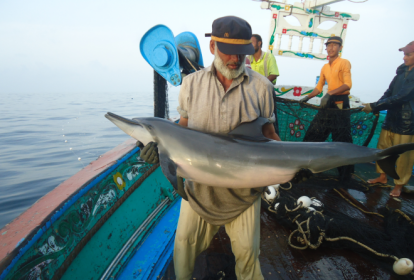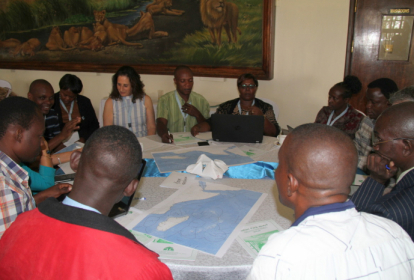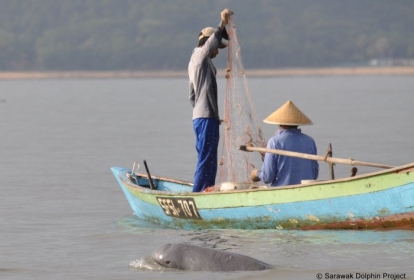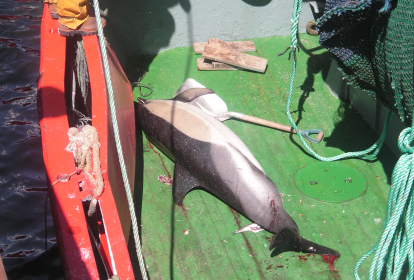Bycatch is a global conservation and fisheries management issue. It is now seen as by far the single most serious, direct threat to cetaceans. Globally, it is estimated that at least 300,000 cetaceans are caught and killed as bycatch every year.
It affects many species including turtles, sea birds, sharks and other non-target fish, as well as marine mammals.
Cetaceans can become entangled or wrapped in various types of fishing gear including nets, ropes and lines. Smaller species often die immediately as they are unable to reach the surface to breathe. The large size of some cetacean species means entanglement may not kill them immediately but instead can become a serious welfare issue as they tow heavy ropes, buoys and nets for weeks, months or years before dying.
Bycatch of cetaceans occurs in all kinds of fishing operations: from large industrial to localised artisanal fisheries. It also occurs in most types of fishing gear.
Gillnets and entangling nets are known to cause the highest amount of cetacean bycatch. Large whales are particularly susceptible to becoming entangled in nets and ropes associated with pots and traps and Fish Aggregating Devices (FADs) which are used to attract fish.
In general, across the world's fisheries there is quite limited bycatch monitoring, data collection and reporting of data. This makes it difficult to assess and identify priority locations and populations on national and international scales. Some technical solutions do exist for assessment, monitoring and mitigation, and work is ongoing to promote proven uptake of these solutions and appropriate testing of them in fisheries around the world.
The scale of the problem means effective mitigation is only possible if many different organisations, disciplines and stakeholder groups work together with the fishing community, fisheries management organisations and governments, and consideration is given to the social, economic and environmental aspects of the problem.
The Bycatch Mitigation Initiative (BMI)
As the leading global body addressing cetacean science, conservation and management, the IWC has the capacity to play a significant role in global efforts to address bycatch and in 2016, endorsed a new Bycatch Mitigation Initiative (BMI). In collaboration with other organisations, national governments and fishing communities, this aims to develop, assess and promote effective bycatch prevention and mitigation measures world-wide.
Collaboration with the FAO
A key partner in bycatch mitigation is the Fisheries and Agriculture Organisation of the United Nations (FAO). The IWC has worked in partnership with the FAO to develop advice aimed primarily at fishery managers, fishers and researchers.
The first key collaboration was a development of guidelines to prevent and reduce bycatch of marine mammals in capture fisheries, published in 2021. This was followed by a series of 12 factsheets which summarise and illustrate mitigation measures including acoustic deterrent devices (also known as pingers), how to switch of modify fishing gear types, and temporary area closures.
- Marine Mammal Bycatch Mitigation Factsheets
- FAO Guidelines to prevent and reduce bycatch of marine mammals in capture fisheries.
BMI Structure and Objectives
The structure of the BMI includes:
- a Standing Working Group to oversee the initiative;
- a multi-disciplinary Expert Panel to provide specialist advice;
- a Bycatch Co-ordinator who brings technical expertise in the field of bycatch and leads the work programme.
The BMI has a 10-year strategic plan and a four-year workplan (2021-24).
The initiative is currently focused on addressing gillnet bycatch in small-scale fisheries, although some work continues on bycatch in other gears and fisheries. The BMI concentrates on four main areas:
- improved assessment of bycatch to determine priorities and to measure success;
- innovation and testing of mitigation and management methods and approaches (no single solution exists to prevent cetacean bycatch);
- capacity building and transfer of expertise, technology and management measures between countries and fishing communities;
- engagement and collaboration with other relevant international organisations focused on fisheries management and bycatch.
The concepts of collaboration and co-ordination underpin the BMI. Bycatch is an issue that needs to be tackled on several different scales, from fishing communities to national governments and intergovernmental fishery bodies.
The BMI works closely with the Global Whale Entanglement Response Network (GWERN), a pioneering initiative which actively addresses welfare, conservation and human safety impacts of large whale entanglement in fishing gear and marine debris.
Further reading on the BMI:




